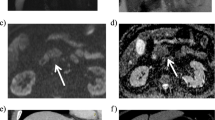Abstract
Purpose
To investigate the added value of diffusion-weighted imaging (DWI) when used with conventional T2-weighted magnetic resonance (MR) imaging (T2WI) and MR cholangiopancreatography (MRCP) for diagnosing bile duct dilatations.
Methods
Our institutional review board approved this retrospective study protocol and waived the informed consent requirement. The study included 151 consecutive patients (70 men, 81 women) with intra- and/or extra-hepatic bile duct dilatation examined using MR imaging. Two radiologists independently and randomly reviewed 3 image sets (A: MRCP and T2WI; B: DWI; and C: combined T2WI, MRCP, and DWI) at different occasions to differentiate between malignancy, biliary lithiasis, and benign dilatation. The sensitivity, specificity, and diagnostic accuracy of these imaging sets were calculated and compared.
Results
For both readers, combined T2WI, MRCP, and DWI exhibited significantly higher sensitivity and diagnostic accuracy for malignant dilatation, compared with conventional T2WI and MRCP (P < 0.01 for both readers). However, DWI did not significantly affect the sensitivity and diagnostic accuracy for biliary lithiasis or benign dilatation.
Conclusion
The addition of DWI to T2WI and MRCP sequences yields significantly higher sensitivity and diagnostic accuracy when examining bile duct dilatations, particularly malignant dilatations.





Similar content being viewed by others
References
Kim MJ, Mitchell DG, Ito K, Outwater EK (2000) Biliary dilatation: differentiation of benign from malignant causes—value of adding conventional MR imaging to MR cholangiopancreatography. Radiology 214:173–181
Soto JA, Alvarez O, Lopera JE, et al. (2000) Biliary obstruction: findings at MR cholangiography and cross-sectional MR imaging. Radiographics 20:353–366
Mittal PK, Moreno CC, Kalb B, et al. (2015) Primary biliary tract malignancies: MRI spectrum and mimics with histopathological correlation. Abdom Imaging 40:1520–1557
Kim JH, Kim MJ, Chung JJ, et al. (2002) Differential diagnosis of periampullary carcinomas at MR imaging. Radiographics 22:1335–1352
Lim JH, Kim MH, Kim TK, et al. (2003) Papillary neoplasms of the bile duct that mimic biliary stone disease. Radiographics 23:447–455
Koh DM, Collins DJ (2007) Diffusion-weighted MRI in the body: applications and challenges in oncology. AJR Am J Roentgenol 188:1622–1635
Padhani AR, Liu G, Koh DM, et al. (2009) Diffusion-weighted magnetic resonance imaging as a cancer biomarker: consensus and recommendations. Neoplasia 11:102–125
Qayyum A (2009) Diffusion-weighted imaging in the abdomen and pelvis: concepts and applications. Radiographics 29:1797–1810
Cui XY, Chen HW, Cai S, et al. (2012) Diffusion-weighted MR imaging for detection of extrahepatic cholangiocarcinoma. Eur J Radiol 81:2961–2965
Chung YE, Kim MJ, Kim HM, et al. (2011) Differentiation of benign and malignant ampullary obstructions on MR imaging. Eur J Radiol 80:198–203
Yoo RE, Lee JM, Yoon JH, et al. (2014) Differential diagnosis of benign and malignant distal biliary strictures: value of adding diffusion-weighted imaging to conventional magnetic resonance cholangiopancreatography. J Magn Reson Imaging 39:1509–1517
Park HJ, Kim SH, Jang KM, et al. (2014) The role of diffusion-weighted MR imaging for differentiating benign from malignant bile duct strictures. Eur Radiol 24:947–958
Roth CG (2011) Fundamentals of body MRI, 1st edn. Philadelphia: Elsevier, pp 178–180
Piana G, Trinquart L, Meskine N, et al. (2011) New MR imaging criteria with a diffusion-weighted sequence for the diagnosis of hepatocellular carcinoma in chronic liver diseases. J Hepatol 55:126–132
Sevcenco S, Heinz-Peer G, Ponhold L, et al. (2014) Utility and limitations of 3-Tesla diffusion-weighted magnetic resonance imaging for differentiation of renal tumors. Eur J Radiol 83:909–913
Jang KM, Kim SH, Min JH, et al. (2014) Value of diffusion-weighted MRI for differentiating malignant from benign intraductal papillary mucinous neoplasms of the pancreas. AJR Am J Roentgenol 203:992–1000
Hekimoglu K, Ustundag Y, Dusak A, et al. (2008) MRCP vs. ERCP in the evaluation of biliary pathologies: review of current literature. J Dig Dis 9:162–169
Bammer R (2003) Basic principles of diffusion-weighted imaging. Eur J Radiol 45:169–184
Naganawa S, Kawai H, Fukatsu H, et al. (2005) Diffusion-weighted imaging of the liver: technical challenges and prospects for the future. Magn Reson Med Sci 4:175–186
Kandpal H, Sharma R, Madhusudhan KS, Kapoor KS (2009) Respiratory-triggered versus breath-hold diffusion-weighted MRI of liver lesions: comparison of image quality and apparent diffusion coefficient values. AJR Am J Roentgenol 192:915–922
Author information
Authors and Affiliations
Corresponding author
Rights and permissions
About this article
Cite this article
Tsai, TH., Hsu, JS., Lai, ML. et al. Added value of diffusion-weighted imaging to MR cholangiopancreatography for the diagnosis of bile duct dilatations. Abdom Radiol 41, 485–492 (2016). https://doi.org/10.1007/s00261-015-0612-8
Published:
Issue Date:
DOI: https://doi.org/10.1007/s00261-015-0612-8




